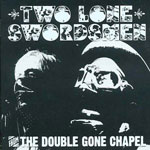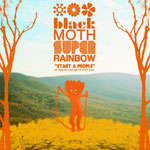
Thereís a great line from former Sabre of Paradise Andrew Weatherall in issue 2 of Loose Lips Sink Ships where he talks about how his vision of the future has always been more Brazil than THX 1138. I think that really hits the nail on the head, and itís fitting that it comes from Weatherall because he more than anyone has made the music that fits with that vision. Itís there in the old Sabres records, most notably in the magnificent Haunted Dancehall and itís there in the just released Double Gone Chapel album by the Two Lone Swordsmen project that is Weatherall and Keith Tenniswood. Not that itís really an electronic album at all of course, being filled with guitars and Ďrealí drums, but who cares anyway, right?
Maybe itís the sad trainspotter in me, but I do love seeing people make reference to other things of importance. So it is with Double Gone Chapel (on the legendary Warp records), whose title is a reference to the classic Jim Dodge novel Not fade Away. Really you need no more reason to buy the record than for that. I mean, anyone who has the sweet sense to reference such genius has to be worth investigating, right? Not Fade Away is all about the search for mythology, about immersion in obsessive nostalgia, and Double Gone Chapel rummages in the same themes. The spirit of early rockíníroll then pervades the record in the way that the same spirit seeped through Not Fade Away and indeed through early Punk, and thatís no surprise really when you consider Weatherallís illustrious history. And really Double Gone Chapel is a great Punk / post-Punk album that I swear could be slotted next to Suicide or PiL and not sound out of place.
Thereís also a great reference in opener ĎStack Upí to those old record players with the long centre spindles on which you could stack ten singles, an early analogue version of the iTunes playlist no less. We had an old red Marconiphone player and some of my first memories of music are of stacking up old Johnny Ray, Elvis and Teddy Bears singles on that and dancing around the bedroom with a tennis racket.
Double Gone Chapel then is a record that takes these hues of sharp nostalgia and infuses them with a contemporary infatuation with fractured societies, and really that whole Brazil parallel is so apt, because this does sound like a vision of a future filled with paranoia and brittle facades of pleasure. Itís the kind of record that burrows into your psyche, the kind of record that demands repeated playings and that gives out more with each revolution. A contender for Record Of The Year if ever there was one.

Warp of course continue to be a rare delight of a label, although it remains a mystery to me why they have not picked up on Black Moth Super Rainbow, whose new Start A People collection has just been released on Graveface / 70s Gymnastics Recording Co. I first came across this naturally strange duo in 2001 when the autumn kaleidoscope got changed album (by Black Moth precursors satanstompingcaterpillars) dropped unannounced on my desk. Since then thereís been an album a year from the Pittsburgh based pair, each of them stacked with the kind of strangely beautiful electronic sounds that people like Boards of Canada might make if they spent a summer staring at clouds from the roofs of barns, dredging up long hidden childhood memories. And that really is the key to Black Moth Super Rainbow: their records are infused with the burnt out colour and shaky vision of degrading super 8 home movies, of mildewed photographs discovered in abandoned farm houses, of rusting wind up toy race cars with keys long since lost. Black Moth Super Rainbow are obsessed with ideas of self-imposed nostalgia, of the self myth-making process. As such they continually tinker with old songs, giving them different hues each time they record them, like a process painter obsessing over the subtle differences in their canvases. The results are of course magical: rustic electronica of the highest order that youíd be mad to miss. Someone tell Warp to release it in the UK! Make Black Moth Super Rainbow the strange stars they surely deserve to be.
© 2004 Alistair Fitchett